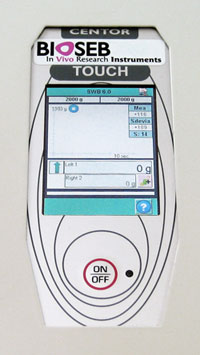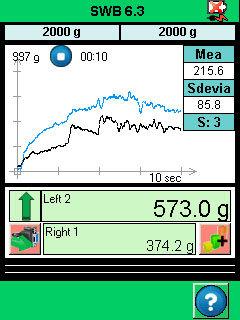
The Contextual Kits for T2CT have been designed to enhance thermal place preference studies...

The Contextual Kits for T2CT have been designed to enhance thermal place preference studies...
Discover our products
An easy way to objectively quantify the muscular strength of mice and rats, and to assess the...
Discover our products
The BIOSEB Spontaneous Activity Wheel offers an effective solution for quantifying rodent...
Discover our products
The BIOSEB Spontaneous Activity Wheel is an easy way to quantify rodent voluntary activity in...
Discover our products
The uncomplicated way to monitor rodent activity over several days from their home cage...
Discover our products
These small animal treadmills are used for forced exercise training and accurate testing of...
Discover our products
For testing animal's thermal sensitivity to pain resulting from exposure to heat or cold: the...
Discover our products
An operator independent test to study pain thresholds in rodents (mouse and rat) by assessing...
Discover our products
New and improved! The operator-independent Thermal Gradient Test used to show favorite...
Discover our products
The Contextual Kits for T2CT have been designed to enhance thermal place preference studies...
Discover our products
The advanced version of our Dynamic Weight Bearing Test for rodents (rats and mice) allows for...
Discover our products
An easy and non pain-inducing solution for assessing the level of discomfort (incapacitance) in...
Discover our products
A unique device that provides automated measurement of weight bearing and force distribution...
Discover our products![Postural Module [Add-on]](https://bioseb.com/733-home_default/dynamic-weight-bearing-20-add-on-postural-module.jpg)
Expand Your Analysis with Advanced Postural and Locomotor Calculations BIOSEB’s renowned...
Discover our products
A quick solution to determine the mechanical sensitivity threshold in rodents (mice and rats)....
Discover our products
As an electronic version of the classical Von Frey Filaments esthesiometer (or aesthesiometer),...
Discover our products
New ROBUST and modular cages to gently hold rodents (rats or mice) during nociceptive and...
Discover our products
An economical and versatile solution for when flexible quantitative sensory testing (QST) is...
Discover our products
Dedicated to small animals, like mice and rats, Smalgo is a pressure-based analgesimeter...
Discover our products
Bioseb's version 5 of the Tail Suspension Test system, based on both strain sensors and video...
Discover our products
NEW ! A complete (hardware + software), dedicated and automated solution for the Elevated Plus...
Discover our products
A unique setup for the automation of the Open Field test for rats and mice : 3D-camera based...
Discover our products
Open-field test - ARENA ONLY - used to evaluate of animal's basal activity and its evolution for...
Discover our products
The new Forced Swimming Test system from Bioseb uses a dual approach: Combining a double input...
Discover our products
A brand new innovative setup for the automation of the Novel Object Recognition Test : 3D-camera...
Discover our products
Open-field test - ARENA ONLY - used to evaluate of animal's basal activity and its evolution for...
Discover our products
An entirely modular experimental enclosure designed to conduct operant conditioning procedures...
Discover our products
A standard experimental chamber for automated or manual assessment of conditioned place...
Discover our products
Real-Time Physiological Monitoring for Small Animals – Wireless & Non-Invasive The Bioseb...
Discover our products
The ETH-401 is a bridge amplifier for various transducers that provides four channels of...
Discover our products
The IX-118 is a fast 100 Khz, high-resolution data acquisition system suitable for most data...
Discover our products
The ETH-256 is a 2 channels high performance, general-purpose life science research amplifier,...
Discover our products
Full-featured multi-channel stimulator for neuromuscular stimulation
Discover our products
Discover BIO-FOODIS, the next generation solution for understanding animal feeding behavior with...
Discover our products
The OXYLET system - Physiocage is a modular system allowing the integration of respiratory...
Discover our products
Innovative and appropriate equipment for measuring food/liquid consumption and correlated motor...
Discover our products
An economical, high performance Oxygen and Carbon Dioxide Analyzer with sampling rates fast...
Discover our productsAn easy and non pain-inducing solution for assessing the level of discomfort (incapacitance) in the injured paw of a small animal like a rat or a mouse by measuring the Postural Equilibrium “ independently of the operator". The static weight bearing instrument is ideal for your research on analagesia and nociception involving rodents: osteo arthrisis, cartilage degeneration, inflammation models, nerve injury models, and much more... Discover the SWB-Touch: now with a brand new touch-screen console!
![]()
![]()
![]() Presentation
Presentation

While normal rats and mice distribute weight equally on both paws, the ratio of weight distribution between injured and non injured paw is a natural measurement of the level of discomfort in the injured paw of a rodent, which correlates with the Paw Pressure Analgesia Meter (Randall and Sellito test). Bioseb Incapacitance Test or Static Weight Bearing (SWB Touch) Test allows you to measure this weight distribution and thus to easily and accurately estimate the level of discomfort.
By continuously measuring the weight borne by each paw, Bioseb's Static Weight Bearing Incapacitance Test allows the objective measurement of spontaneous pain by assessing the postural equilibrium, thus opening research fields not available when using traditional methods (like the Randall & Selitto test), which can only measure nociceptive thresholds and pain sensitivity using experimental nociceptive stimuli.
Research applications for Bioseb's Static Weight Bearing Incapacitance Test include nerve or tissue injury, Neuropathy, Carrageenin, Incision recovery, osteo-arthrisis, cartilage degeneration, inflammation models (CFA), peripheric nerve injury models, mechanical hyperalgia models, bone cancer pain models, and much more...![]() Operating principle
Operating principle
During the static weight bearing test, the rodent (rat or mouse) is placed into a holder holder where the animal is comfortably maintained while his hind paws rest on two separate sensor plates. The animal stands and makes a natural adjustment to the degree of pain by adapting weight distribution on both rear paws.
The spontaneous value of the weight applied on each sensor is displayed on the LCD screen of the control unit, which can also show statistical calculations. Now with a brand new touch-screen console! Using the optional remote foot-switch, the operator can start/stop the test hands-free. No PC is required during the experiment, but you have the option to send data to a software through the integrated RS-232 interface. ![]()

Main functionalities
Bioseb Incapacitance Test (Static Weight Bearing) offers numerous unique and innovative features for facilitating your research on nociception and analgesia :
• A non pain-inducing method to measure discomfort: The animal stands and makes a natural adjustment to the degree of pain by adapting weight distribution on both rear paws.
• An objective spontaneous pain measurement solution: Dual channel scale based measurement is done independently of the operator’s reaction time or subjective judgment about the animal’s flinching.
• An easy and precise instrument: No restraint requirements, a footswitch to tare scales, direct display of the average value on the LCD for each of the back paws.
• A stand alone instrument: No PC is required for running the incapacitance test, although you have the possibility to send collected data from the instrument to a PC through the integrated RS232 interface. It can also be run on battery.
• The Incapacitance (Static Weight Bearing) Test allows the user to compute and display statistics (mean, sd) for groups of rodents (rats or mice) during the measurement process.
• Units are selected by the user in grams, Newtons or oz/lbs.
• The Instrument has an internal memory of up to 200 individual values (ie 1 animal, 2 paws) or up to 200 groups when the statistics are used. Those values are available for editing directly on the sceen, or to be printed out or transferred to a PC, later on. Transfert includes date and time for glp protocols.
• Independent platform and control unit: a 1 meter cable allows some distance between the animal and the operator, reducing the placement time.
Data sheet
Number of publications:
The advanced version of our Dynamic Weight Bearing Test for rodents (rats and mice) allows for faster paw identification,...
A unique device that provides automated measurement of weight bearing and force distribution over time during voluntary...
Expand Your Analysis with Advanced Postural and Locomotor Calculations
BIOSEB’s renowned Dynamic Weight...
check_circle
check_circle